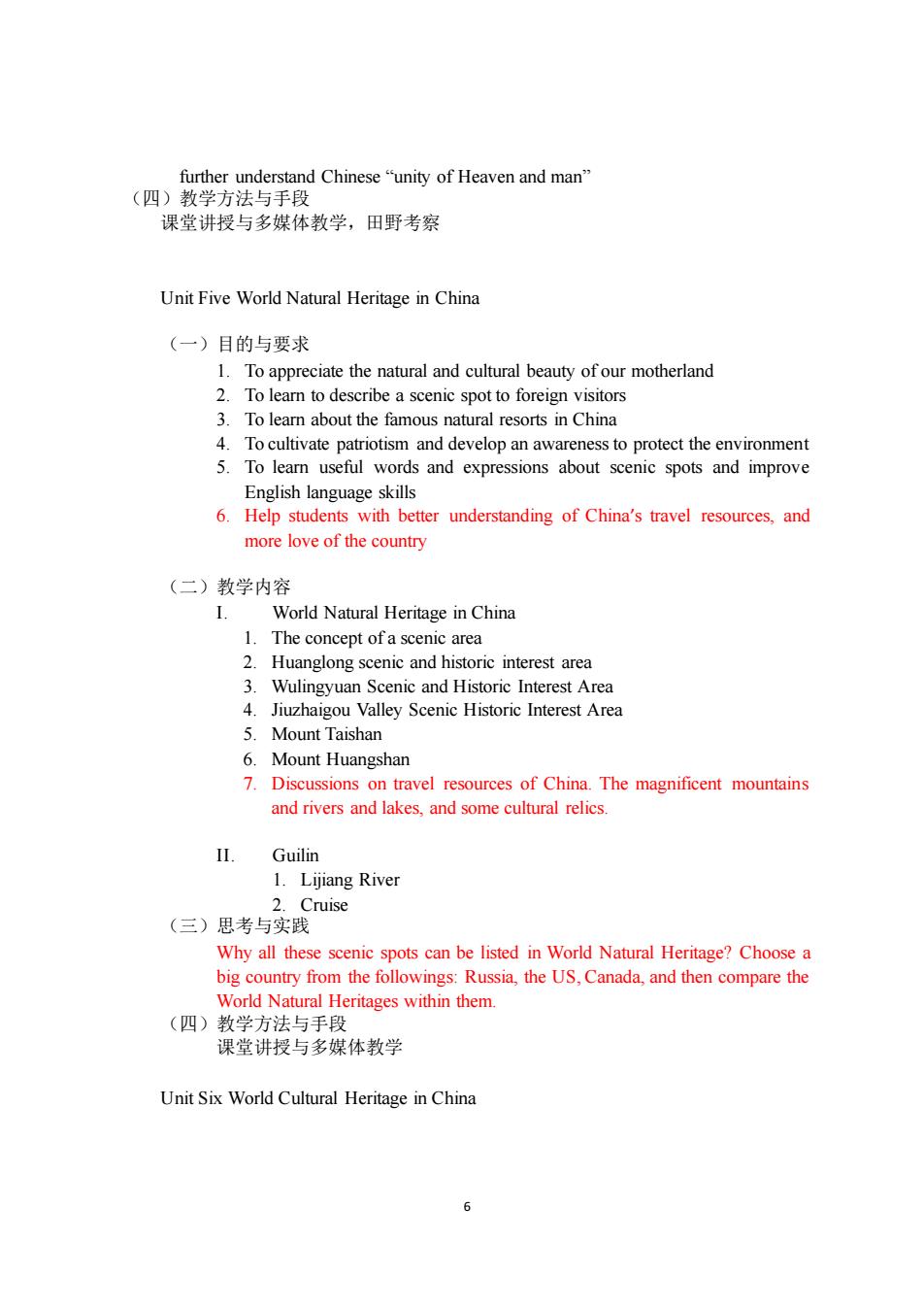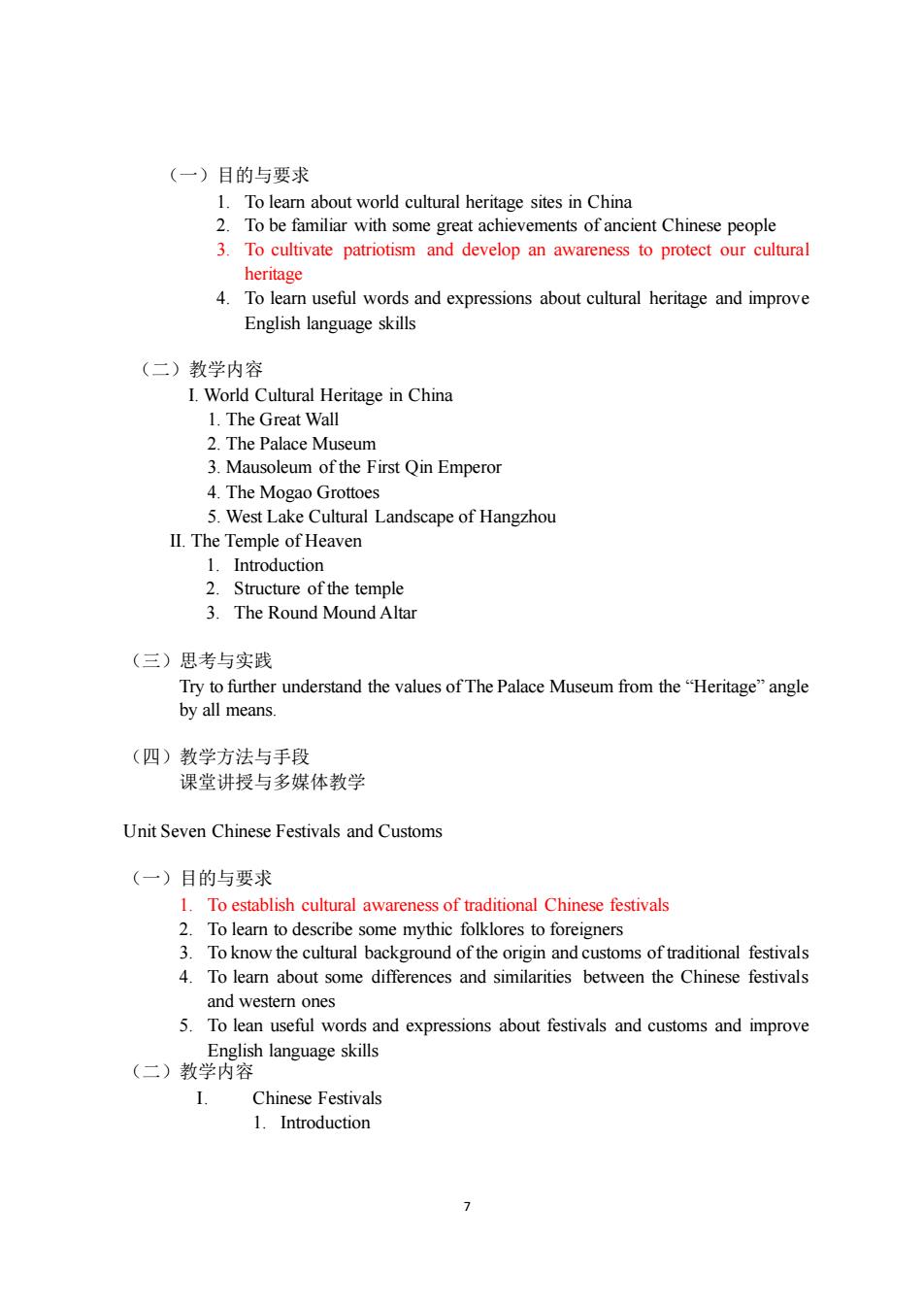
further understand Chinese"unity of Heaven and man" (四)教学方法与手段 课堂讲授与多媒体教学,田野考察 Unit Five World Natural Heritage in China (一)目的与要求 1.the natural and cra eauty of our otherland 2.To lam to describ a scenic spot to foreign visitors 3 To learn about the famous natural resorts in China 4.To cultivate patriotism and develop an awareness to protect the environment 5.To learn useful words and expressions about scenic spots and improve English language skills 6.Help students with better understanding of China's travel resources,and more love of the country (二)教学内容 World Natural Heritage in China 1.The concept ofa sce area 2. and historic interest area 3. Wulingyuan Scenic and Historic Interest Area 4. Jiuzhaigou Valley Scenic Historic Interest Area 5 Mount Taishan 6.Mount Huangshan 7.Discussions vel resources of China. The magnificent mountains and rivers and lakes,and some cultural relics. II.Guilin 1.Liiiang River (三)思考与头 Why all these scenic spots can be listed in World Natural Heritage?Choose a big country from the followings:Russia,the US.Canada,and then compare the World Natural Heritages within them. (四)教学方法与手段 课堂讲授与多媒体教学 Unit Six World Cultural Heritage in China
6 further understand Chinese “unity of Heaven and man” (四)教学方法与手段 课堂讲授与多媒体教学,田野考察 Unit Five World Natural Heritage in China (一)目的与要求 1. To appreciate the natural and cultural beauty of our motherland 2. To learn to describe a scenic spot to foreign visitors 3. To learn about the famous natural resorts in China 4. To cultivate patriotism and develop an awareness to protect the environment 5. To learn useful words and expressions about scenic spots and improve English language skills 6. Help students with better understanding of China’s travel resources, and more love of the country (二)教学内容 I. World Natural Heritage in China 1. The concept of a scenic area 2. Huanglong scenic and historic interest area 3. Wulingyuan Scenic and Historic Interest Area 4. Jiuzhaigou Valley Scenic Historic Interest Area 5. Mount Taishan 6. Mount Huangshan 7. Discussions on travel resources of China. The magnificent mountains and rivers and lakes, and some cultural relics. II. Guilin 1. Lijiang River 2. Cruise (三)思考与实践 Why all these scenic spots can be listed in World Natural Heritage? Choose a big country from the followings: Russia, the US, Canada, and then compare the World Natural Heritages within them. (四)教学方法与手段 课堂讲授与多媒体教学 Unit Six World Cultural Heritage in China

(一)目的与要求 1 To learn about world cultural heritage sites in china 2.To be familiar with some gre eat achie hents of ancient Chinese people 3.To cultivate patriotism and develop an awareness to protect our cultural heritage 4.To learn useful words and expressions about cultural heritage and improve English language skills (二)教学内容 World Cultural Heritage in China 1.The Great Wall 2.The Palace Museum 3.Mausoleum of the First Qin Emperor 4.The Mogao Grottoes 5.West Lake Cultural Landscape of Hangzhou II.The Temple of Heaven 1.Introduction 2.Structure of the temple 3 The round mound altar (三)思考与实践 Try to further understand the values of The Palace Museum from the"Heritage"angle by all means. (四)教学方法与手段 课堂讲授与多媒体教学 Unit Seven Chinese Festivals and Customs (一)目的与要求 Toestablish cultural awareness of traditional Chinese festivals 2.To learn to describe some mythic folklores to foreigners 3.To know the cultural background of the origin and customs of traditional festivals 4.To learn about some differences and similarities between the Chinese festivals and western ones 5.To lean useful words and expressions about festivals and customs and improve English language skills (二)教学内容 Chinese festivals 1.Introduction
7 (一)目的与要求 1. To learn about world cultural heritage sites in China 2. To be familiar with some great achievements of ancient Chinese people 3. To cultivate patriotism and develop an awareness to protect our cultural heritage 4. To learn useful words and expressions about cultural heritage and improve English language skills (二)教学内容 I. World Cultural Heritage in China 1. The Great Wall 2. The Palace Museum 3. Mausoleum of the First Qin Emperor 4. The Mogao Grottoes 5. West Lake Cultural Landscape of Hangzhou II. The Temple of Heaven 1. Introduction 2. Structure of the temple 3. The Round Mound Altar (三)思考与实践 Try to further understand the values of The Palace Museum from the “Heritage” angle by all means. (四)教学方法与手段 课堂讲授与多媒体教学 Unit Seven Chinese Festivals and Customs (一)目的与要求 1. To establish cultural awareness of traditional Chinese festivals 2. To learn to describe some mythic folklores to foreigners 3. To know the cultural background of the origin and customs of traditional festivals 4. To learn about some differences and similarities between the Chinese festivals and western ones 5. To lean useful words and expressions about festivals and customs and improve English language skills (二)教学内容 I. Chinese Festivals 1. Introduction